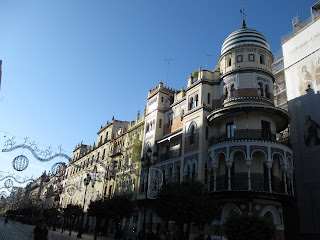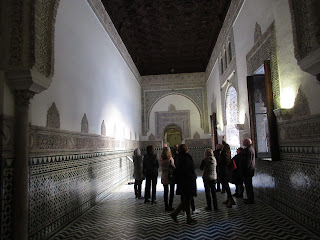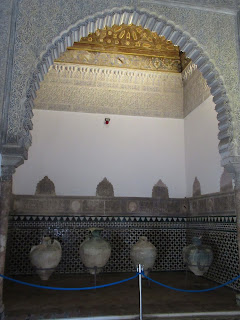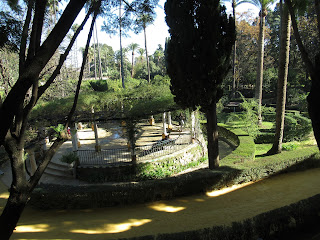Sorry for the delay since the last post. I was away on vacation in New Zealand and Australia for the last 3.5 weeks and only just returned two days ago. In case you also want to follow that trip, here's a link to the newest blog: www.bergersadventures7.blogspot.com
Our first sight that morning was the attractive Real Iglesia de San Antonio Abad.
Our first sight that morning was the attractive Real Iglesia de San Antonio Abad.
A little further on was a statue of a Flamenco dancer as the art form was especially popular in Sevilla. We were really looking forward to see a Flamenco show that night that we'd reserved several months ago.
I was perplexed why there was a mosaic depicting the American Studebaker car.
The pleasant Plaza Nueva or New Square was the location for the relatively modern City Hall. The square had been the location for executions and bullfights,; nowadays, it's used for big city events.
The center of the square had a commanding statue of King Ferdinand III who liberated Sevilla from the Moors in the 13th century and was later sainted. For many centuries, a huge Franciscan monastery stood on this site and the square was a spiritual home to many of the missionaries who colonized California's coast. However, it was destroyed in 1840, when the monastic system was disbanded by a government anxious to take back power from the Roman Catholic Church.
The square was a gateway to Sevilla's shopping district and a superb collection of historic buildings.
Small tobacco shops were a common fixture throughout the city, we observed.
While Granada had the great Alhambra and Cordoba its remarkable Mezquita, Sevilla's claim was the Alcazar, a fantastic royal palace and garden decorated with a mix of Islamic and Christian elements, a style called Mudejar. We entered through the impressive garden-like Lion Courtyard
Just beyond was the Courtyard of the Hunt, the main entrance to the palace that was built over many centuries with rooms and decorations from the various rulers who lived there. The original 10th century palace and gardens were built by Moorish caliphs. King Pedro I built the most famous part of the complex after Sevilla was Christianized in 1248. During Spain's Golden Age, the palace was home to Ferdinand and Isabel and later by their grandson, Charles V. Later monarchs added more luxury and Spain's current king and queen occupy the palace's upper floor as one of their royal residences.
The pink and red Audience Chamber was formerly a chapel; its altarpiece painting was St. Mary of the Navigators from the 1530s. The Virgin - the patron saint of sailors and a favorite of Columbus - was shown keeping watch over the small ships beneath her.
As noted by Rick Steves, the travel writer, her cape seemed to protect everyone under it, even the Native Americans in the dark background. That was the first time 'Indians' were painted in Europe.
In another part of the painting, was none other Christoper Columbus, depicted with his hands joined in prayer and standing on a cloud because it was painted a few decades after his death and he was in heaven. Steves indicated that many historians believe this to be the earliest known portrait of Columbus.
Beside the painting was a model of Columbus' Santa Maria, his flagship and the only of his thee ships not to return after his 1492 voyage. The big cargo ship ran aground on Christmas Day off present-day Haiti.
Opposite the altarpiece was the family coat of arms belonging to Columbus' descendants who now live in Spain and Puerto Rico. It read "To Castile and to Leon, Colon (Columbus' Spanish name) gave a new world."
When Queen Isabel debriefed Columbus after his discoveries in the New World, she understood that what he'd found could have major importance for Spain. An ornate wing was created in the palace in 1503 to administer Spain's New World's adventures. It was in the Admiral's Hall that Columbus discussed his travels, Ferdinand Magellan planned his around the world voyage and Amerigo Vespucci tried to come up with a name for the newly found continent.
The largest and most melodramatic painting showed a critical point in Sevilla's history with King Ferdinand III kneeling humbly before the bishop, giving thanks to God for helping him free the city from the Muslims in 1248. Ferdinand promptly turned the Alcazar into the royal palace for Christian kings.
The next room had a large collection of mostly foreign fans.
This 19th century one was made with painted ivory, a Cupid on the frame and delicate Chantilly lace.
The commemorative fan celebrated the royal wedding of King Alfonso XII and Maria Cristina in 1878.
This ivory and Brussels lace fan was my favorite.
We returned to the Courtyard of the Hunt to face the impressive palace facade which was the entrance to King Pedro I's Palace, the 14th century nucleus of the Alcazar. Its elaborate blend of Islamic tracery and Gothic Christian elements was an introduction to the Mudejar style seen throughout Pedro's part of the palace.
Note the ornate floors and ceiling in the Entrance Hall.
The Courtyard of the Maidens was the center of King Pedro's palace; it was an open-air courtyard, surrounded by rooms with a long, rectangular reflecting pool in the center. Pedro built his palace around water just like the Moors had done before him.
The palace is considered Spain's best example of the Mudejar style with colorful ceramic tiles, stucco panels with elaborate designs and coffered wooden ceilings.
The Charles V Ceiling Room may have been the ancient chapel in Pedro's Palace. The exquisite paneled ceiling was created between 1541 and 1543. Charles V, who ruled Spain at its peak of New World wealth, increased the size of the palace after his marriage to Isabel joined vast realms of Spain and Portugal.
The two main rooms in the Royal Bedroom were divided by horseshoe arches crowned with shells, the symbol of the human life cycle. The original ceramic floor was mixed with Renaissance marble made by Carlos V in the Royal Alcazar.
More scenes from the Courtyard of the Maidens:
The palace's most important room was the Hall of the Ambassadors. It was in this throne room where Pedro received guests and partied in luxury. Like many important Islamic buildings, the room was a cube topped with a half-dome. In Islam, a cube symbolized the earth and the dome, the starry heavens. In Pedro's world, the symbolism proclaimed that he controlled heaven and earth,
The marvelous stucco on the walls was molded with interlacing plants, geometric shapes and Arabic writing even though it was a Christian palace. The walls were inscribed with Muslim sayings like "None but Allah conquers" and "Happiness and prosperity are benefits of Allah, who nourishes all creatures."
The Mudejar style included Christian motifs, including the row of kings, high up at the base of the dome, chronicling all of Castile's rulers from the 600s to the 1600s. Throughout the palace, as in the center of the dome, were also coats of arms including the castle of Castile and the lion of Leon.
There were also shells and birds and other natural objects which wouldn't normally be seen in Islamic decor as it traditionally avoids realistic images of nature or or people.
Straight ahead from the Hall of the Ambassadors was the Philip II Ceiling Room with peacocks, falcons, and other birds amid interlacing vines.
The Prince's Suite comprised a central hall and two smaller rooms with beautiful ceilings in each. Rarely had we been in any place that encouraged us to keep looking up at the ceilings in each room as in the Alcazar.
The Prince Garden preserved the Muslim influence with the layout of the courtyard in four sections. Aromatic rosemary and myrtle plants offered pleasant aromas. Asian lemon trees were introduced in the Muslim era.
Even the wrought iron doors and windows had lovely detailing.
On the upper floor was the Banquet Hall which had the oldest pictorial representation in the city called the Virgen de la Antigua. It was painted on the wall of the mosque when it was converted to the Catholic religion in the 16th century.
The airy banquet hall was where Charles and Isabel held their wedding reception. Yellow, blue, green and orange tiles lined the room; some of them were decorated with whimsical human figures with vase-like figures.
From the room's windows were gorgeous views of the gardens that we'd explore soon.
Next door, the walls in the Hall of Tapestries were hung with 18th century Spanish copies of 16th century Belgian tapestries showing the conquests, trade and prosperity of Charles' reign. The hall was completely destroyed after the huge Lisbon earthquake in 1755.
The enormous military map tapestry of the Mediterranean world strangely had the south pointing up with Genoa, Italy, on the bottom and Africa on top. The city of Barcelona was placed in the middle because it commanded the most strategic position.
The highlights were described in Spanish along the top and in Latin along the bottom.
At the other end of the room, the wall was filled by a dramatic portrayal of the Spanish Navy as Spain ruled the seas from 1492 until the defeat of the Spanish Armada in 1588.
We had enjoyed ourselves immensely inside the palace but to see the Mercury Pond, a reservoir fed by a 16th century aqueduct that irrigated the palace's entire garden, was glorious. As only elites had running water, the bronze statue fountain was an extravagant show of power.
This wall on the east side of the garden was part of the original Moorish castle wall. In the early 1600s, when fortifications were no longer needed here, it was redesigned to be a grotto-style gallery.
Steps from the Mercury Pond led into the formal gardens.
From the formal gardens, a tunnel under the palace led to the coolest part of the city, the geometric-styled Moorish garden that we viewed from the Grotto Gallery.
In the gardens, like the rest of the palace, Christian and Islamic traditions merged. Both cultures used water and nature as essential parts of their architecture. The garden's pavilions and fountains only enhanced this. While we as tourists paid to be here, the gardens have been a public garden and free to locals since 1931 when the king was exiled and Spanish citizens took ownership of royal holdings. The Spanish people allowed the king to return to the throne in 1975, but on their terms which included keeping this garden.
We exited the Alcazar via the Alighting Area, once the entrance for guests arriving by horse carriage. Over this hall a large lounge was built that became the armory which was considered one of the main parts of the palace.
Steven and I had been fantastically lucky that, except for a few school groups and some tours, there weren't masses of people to contend with while we explored the Alcazar. Spending a few hours at this remarkable palace that was a cross between Moorish and European Christian design was sheer bliss. The majestic suite of rooms has to be a highlight of any trip to Spain. It was a visual feast of brightly colored tiles, intricately carved wood, plaster and stone, with lovely tapestries and paintings all set in magnificent gardens.
Next post: Sevilla's Plaza de Espana, the grandest square in all of Europe in my opinion!
Posted at long last on March 26th, 2019, from Littleton, Colorado.
















































































































The Alcazar is really lovely. I need to visit it someday. Janina
ReplyDeleteJanina,
ReplyDeleteYou really do! I think you and Pat would enjoy every minute of your stay in Sevilla as we almost did. You'll see in the next post why we had just a small reservation about our stay in the charming city on our second to last day! Annie